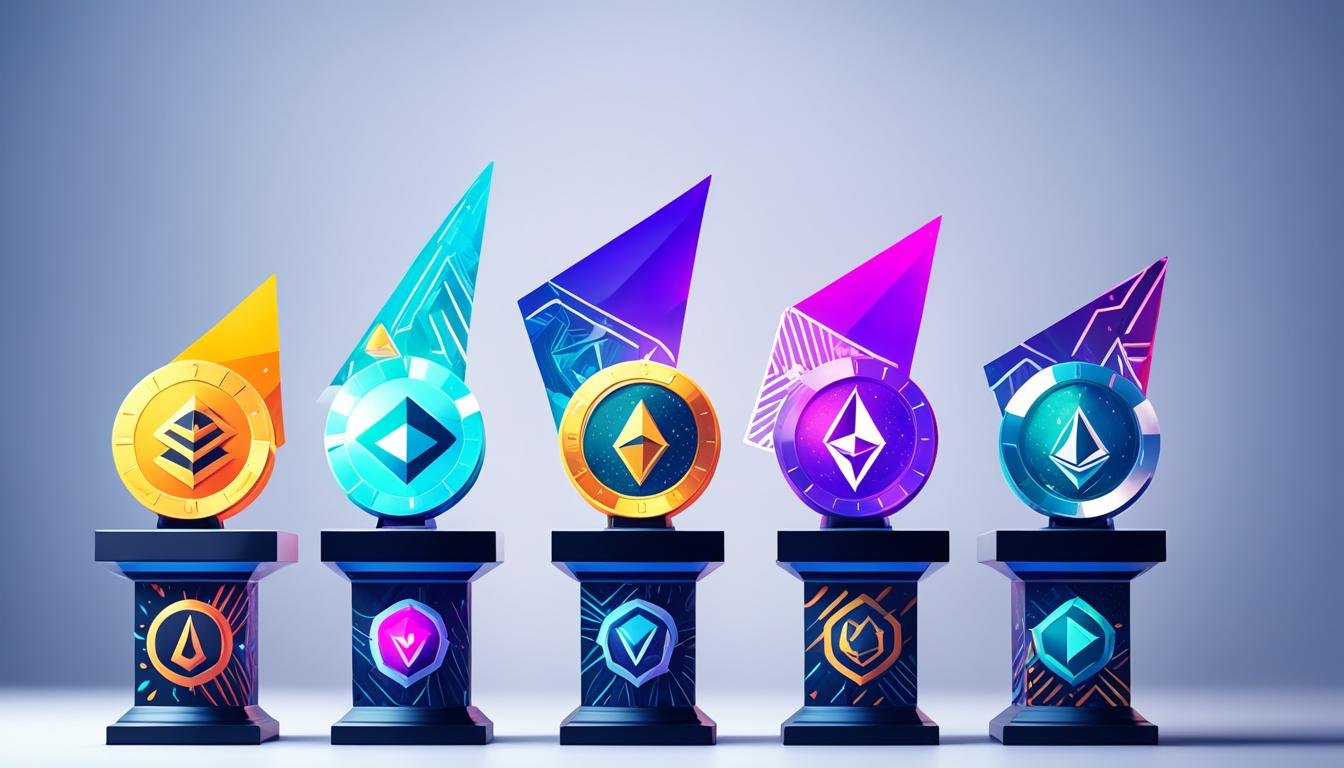Altcoins (Litecoin, Ripple, Cardano): Top Alternatives
Ethereum (ETH) tops the altcoin market with a $418.9 billion market cap. This amount is part of the overall crypto market value. This shows the importance of looking into different altcoins.
Altcoins are cryptocurrencies other than Bitcoin. They offer new chances in the digital money and blockchain field. They deal with issues like slow transactions and scalability. Exploring options like Litecoin, Ripple, and Cardano is key for anyone interested in digital currencies.
Key Takeaways
- Altcoins offer various features and address limitations of Bitcoin such as transaction speed and scalability.
- Ethereum (ETH) leads the altcoin market with a market cap of $418.9 billion.
- Altcoins like Litecoin, Ripple, and Cardano present diverse options for cryptocurrency investments.
- Understanding altcoins is essential for effective diversification in the crypto investment space.
- The growth of altcoins signifies a broader adoption of digital money and blockchain technology.
Introduction to Altcoins
Altcoins are all digital currencies except Bitcoin. They were created to fix some of Bitcoin’s issues. These include slow transactions and limited uses.
What Are Altcoins?
Altcoins provide more than what Bitcoin does. They serve different purposes. Some keep their value stable by connecting to real assets. Others, like Monero, make transactions more private.
There are also altcoins like Filecoin. They let you use certain services through a network without a central authority.
The Rise of Bitcoin and Its Limitations
Bitcoin started the idea of digital money without a central authority. But, it faces issues such as slow transactions and not being able to grow fast. These problems led to the development of altcoins. They aim to improve digital money technology.
The Emergence of Alternative Cryptocurrencies
Since 2016, more cryptocurrencies appeared. This happened as Bitcoin’s share in the market dropped. Altcoins, such as Ethereum and Ripple, introduced new technologies and ways to manage the currency. They added variety to the digital money scene.
As altcoins grew, so did the total value of the cryptocurrency market. This growth allows users to find coins that fit their specific needs. It also drives innovation in the digital money space.
| Type of Altcoin | Key Feature | Example |
|---|---|---|
| Stablecoins | Pegged to external assets | USDT, USDC |
| Privacy Coins | Enhanced anonymity | Monero |
| Utility Tokens | Access to services | Filecoin |
| Governance Tokens | Decision-making rights | Uniswap (UNI) |
| Energy-efficient Coins | Lower energy consumption | Cardano (ADA) |
Understanding Litecoin
Litecoin is often called the “silver to Bitcoin’s gold.” It was created by Charlie Lee. This *digital currency* was made to fix some of Bitcoin’s issues, like slow transactions and not being efficient to mine.
The Creation of Litecoin
Charlie Lee, once a Google engineer, made Litecoin in 2011. It is a global payment network. It’s faster and easier to mine than Bitcoin. Litecoin uses a Scrypt algorithm for mining, which makes it more secure against certain attacks.
Key Features of Litecoin
Litecoin has some special features that make it different from other *digital currencies*:
- Faster Block Generation: It takes Litecoin only 2.5 minutes to create a new block, while Bitcoin needs 10 minutes.
- Increased Supply Limit: Litecoin can have up to 84 million coins, much more than Bitcoin’s 21 million.
- Efficient Reward System: Miners get 6.25 LTC for each block, which is higher than Bitcoin. But, this reward is halved every 840,000 blocks.
- Advanced Mining Algorithm: Litecoin uses the Scrypt algorithm, making it need more power and safer from certain attacks.
Litecoin vs Bitcoin
Litecoin differs from Bitcoin in important ways for *crypto trading* and *blockchain technology*:
| Aspect | Litecoin | Bitcoin |
|---|---|---|
| Market Value (May 2024) | $6.02 billion | Above 40% of global cryptocurrency market |
| Circulating Supply | Over 74 million coins | Approximately 19 million coins |
| Block Generation Time | 2.5 minutes | 10 minutes |
| Coin Limit | 84 million | 21 million |
| Block Reward | 6.25 LTC | 3.125 BTC |
| Halving Interval | Every 840,000 blocks | Every 210,000 blocks |
| Mining Algorithm | Scrypt | SHA-256 |
Litecoin’s quickness and ease of mining make it a strong option in the *crypto trading* world. As *blockchain technology* advances, Litecoin’s unique features show its importance alongside Bitcoin in the *digital currency* sector.
Diving into Ripple (XRP)
Ripple is known for changing international money transfers through blockchains. Unlike other cryptocurrencies, Ripple focuses on making global transactions faster and cheaper.
What is Ripple and XRP?
Ripple started in 2012 and made the XRP Ledger for quick and cheap global trades. XRP is its digital currency, helping in instant money movement. XRP is ranked 7th on CoinMarketCap. It has a $26.64 billion market cap and there are 55,570,463,728 XRP coins in use out of 99,987,531,962.
Ripple’s Unique Features
Ripple can process 1,500 trades per second with a tiny fee of $0.0002 each. It uses a special protocol that makes sure trades are real, cutting down fraud risk. Experts think XRP’s price could hit $0.98 in 2025, $2.50 in 2030, and maybe even $5.50 in 2050.
Use Cases for Ripple
Ripple is great for making global trade faster and cheaper. This helps banks with international money problems and makes them work better. The price of XRP went up by 5.48% not long ago. Experts believe it could hit $0.76 by 2024. The fact that five big money managers want a Spot Ethereum ETF shows how much demand there is for digital finance. This highlights Ripple’s importance in today’s finance world.
| Time Period | Price Prediction |
|---|---|
| 2025 | $0.98 |
| 2030 | $2.50 |
| 2040 | $3.32 |
| 2050 | $5.50 |
Ripple’s technology is key in making global transactions quick, safe, and cost-effective.
Exploring Cardano
Cardano is making a name for itself in the blockchain world. It focuses on making things better, especially for decentralized apps and smart contracts. It offers top-notch solutions for making everything work smoothly and safely.

The Birth of Cardano
It started with a plan to fix the issues of older blockchain tech. Charles Hoskinson, a co-founder of Ethereum, created it for better balance and eco-friendly use of cryptocurrencies.
Cardano’s Technological Foundations
Cardano has a special setup with two key parts. One part deals with money and the other with apps and contracts. This unique setup keeps things safe and running well.
Significance of ADA in the Market
The native token of Cardano, ADA, is very important. Its price jumped by 15% in early May 2024, showing its growth. The interest in its futures rose by $10.5 million. People believe its price will go up to $3.
There’s also a big event coming. It’s called the “Chang Hard Fork” for the “Voltaire” era. It will add 1.5 billion new Cardano tokens for growth and future use.
Cardano shines because of its focus on research and strong tech. It’s doing well in the market and seems set for more success in blockchain and decentralized apps.
Decentralized Finance (DeFi) and Altcoins
In the fast-moving cryptocurrency world, Decentralized Finance (DeFi) is making big waves. It changes how we think about money. DeFi uses blockchain to let people do financial stuff without banks. This opens the door for everyone to use money worldwide.
DeFi uses smart contracts, digital money, and special software, all on the blockchain. It makes money systems more open, safe, and gives users more control. Tokens like Maker, Compound, and Uniswap help people do things like vote, borrow, or trade in this new system.
Ethereum is key to DeFi, thanks to its powerful smart contracts. It allows for building apps that can change how we do money. It’s fundamental to where DeFi is headed.
Other coins, called altcoins, bring even more to DeFi. For example, Litecoin and Bitcoin Cash make payments quicker and cheaper. Cardano focuses on being eco-friendly and secure for smart contracts.
DeFi is made up of many parts like exchanges, lenders, and even games. It lets you control your money better, without big companies.
But, DeFi still faces problems. It can have bugs and is sometimes not safe enough. There are also no strict rules to keep it safe. So, people need to be very careful and do their homework before jumping in.
Still, DeFi and altcoins are changing finance right now. They are creating a new, open, and global way to use money. As they improve, they could really shake things up in finance.
Comparing Litecoin, Ripple, and Cardano
When we look at Litecoin, Ripple, and Cardano, it’s important to consider different things. We focus on how fast they are, the costs, if they can grow, how safe they are, and how much they’re worth.
Transaction Speed and Fees
How fast a crypto can process payments is key. Litecoin is quick, taking about 2 minutes and 30 seconds for a transaction. This means it can handle around 56 transactions each second. Ripple, on the other hand, is even faster, needing just 5 seconds per transaction. It can manage up to 1000 transactions per second. Cardano falls in the middle, with 20 seconds per transaction and the ability to process around 250 per second. Ripple often has lower fees than the others.
Scalability and Security
Scalability, or how well a crypto can grow, matters a lot. Ripple outshines Litecoin and Cardano here. When looking at crypto security, Cardano takes a unique approach. Its blockchain has been thoroughly checked by experts to make it more secure and lasting. Litecoin relies on Ethereum, making sure its security is ready for any challenges.
Market Capitalization and Popularity
Market capitalization tells us how big these cryptocurrencies are in the market. As of July 22, 2023, Cardano is marked at $10.9 billion, Ripple at $39.3 billion, and Litecoin is also significant, though the exact number isn’t given. This shows how much people and investors are interested in them.
| Cryptocurrency | Launch Year | Circulating Supply | Maximum Supply | Transactions Per Second (Max) | Network | Block Time | Market Capitalization (as of July 22, 2023) |
|---|---|---|---|---|---|---|---|
| Litecoin | 2011 | >58 million | 84 million | 56 | Ethereum | 2 minutes 30 seconds | Not specified |
| Ripple (XRP) | 2012 | >18 billion | No upper limit | 1000 | Libp2p | 5 seconds | $39.3 billion |
| Cardano (ADA) | 2015 | >25 billion | 45 billion | 250 | Cardano blockchain | 20 seconds | $10.9 billion |
Investment Strategies for Altcoins
When you invest in altcoins, it’s important to plan carefully to make the most money and lower the chance of losing money. You should spread your money across different altcoins, know what the market is doing, and think about the future while keeping an eye on the present. Let’s take a deep dive into how you can handle these important parts of putting your money in cryptocurrency.
Diversifying Your Crypto Portfolio
Mixing up your investments helps protect against big losses. Spread your money among different altcoins to increase your chances of making money over time. For a $1,000 budget, think about putting half in Bitcoin because it’s well-known. Put 20% in projects like Ethereum and Solana. Give 10% to AI projects, another 10% to the gaming sector, and the final 10% to meme coins or tokens linked to real-world stuff.
Timing and Market Trends
Understanding which way the market is going is crucial. Cryptocurrencies can make a lot of money, but their prices change a lot. Watch big exchanges like Coinbase, Binance, and Kraken to stay on top of price shifts and rules. Knowing the trends helps you know the best times to buy or sell, making your investments more successful in the end.
Long-term vs Short-term Investments
Decide if you want to invest for the long haul or make quick profits. Sticking with altcoins like Ethereum can bring in a lot over time. Or, you can try making fast trades when the market is up and down, but this takes a lot of watching. Mixing both approaches can help you get the best of both worlds. It can reduce your risks while opening the door for more gains.
| Cryptocurrency | Allocation (%) | Investment ($) |
|---|---|---|
| Bitcoin | 50% | $500 |
| Ethereum and Solana (L1 Projects) | 20% | $200 |
| AI-based Projects | 10% | $30 |
| Gaming Sector (Immutable IMX) | 10% | $30 |
| Meme Coins/Real-world Assets Tokens | 10% | $30 |
Risks and Challenges of Investing in Altcoins
Investing in altcoins can have big rewards, but it comes with many risks. It’s important to know these risks to make smart investment choices.
Price Volatility
Price volatility is a big issue with altcoins. Their prices can change fast and in big ways. For example, Ethereum’s value shot up over 13,000% in 2017 alone.
This big growth can tempt investors. But, it’s important to remember these high gains can also mean big losses. Altcoins often use new, untested technology. This adds a layer of risk because the tech might not work well in real situations.
Regulatory Concerns
The world of altcoins is not well-regulated. This has led to scams and fake projects. For example, Exodus did a token offering that the Securities and Exchange Commission checked and gave a go-ahead in 2021.
This kind of official interest could change how the market works. It might make investing in altcoins even more challenging.
Security Issues
Keeping crypto security tight is a big deal. Hacks and cyber threats are everywhere. Altcoins might not be as secure as Bitcoin, which is trusted by many and has strong security.
For investors, this means taking extra steps to keep their investments safe is crucial.
Altcoins deal with problems around how easy it is to buy and sell them. They’re not as easy to turn into cash as Bitcoin is. This can make investing harder.
Yet, looking beyond Bitcoin and Ethereum can open up opportunities. With careful thought and the right strategy, altcoins could bring big returns.
- Cryptocurrency Risks – The market remains highly speculative and subject to rapid changes.
- Investment Challenges – Varying liquidity and market activity levels complicate portfolio management.
- Price Volatility – Unpredictable fluctuations can lead to substantial gains or devastating losses.
- Regulatory Landscape – Evolving regulations may impact market stability and project legality.
- Crypto Security – More vulnerable to hacks and security breaches compared to established coins like Bitcoin.
Future Prospects of Altcoins
Altcoins are gaining more and more attention from both tech specialists and investors. The market has thousands of altcoins, showing growth in diversity. These coins might improve upon or compete with existing digital currencies, promising innovation.
Potential Market Growth
By June 2021, altcoins had grown to over 11,000 types. Big names such as Ethereum and Cardano have become quite valuable. This growth means there are more choices available for digital assets.
Investors often see altcoins as a chance to find lower-priced investments than Bitcoin.
Technological Advances
Blockchain tech is still the main force behind altcoin development. Different types of coins use varying methods for transactions, which affects how fast and how much energy they use. Recent changes include Visa using blockchain tech and a $75 million token offering by Exodus. These events show how much the industry is changing.
Integration with Traditional Finance
Many altcoins are slowly becoming part of traditional finance systems. Big players like Microsoft are starting to accept these coins as payment. Countries and companies are working out new rules for using altcoins in finance. This movement could bring digital cash closer to everyday money systems.
| Altcoin | Market Capitalization (in billions) | Key Feature |
|---|---|---|
| Ethereum (ETH) | $418.9 | Smart Contracts |
| Binance Coin (BNB) | $89.8 | Binance Ecosystem |
| Solana (SOL) | $68.5 | DeFi Applications |
| Dogecoin (DOGE) | $19.9 | Meme Coin Popularity |
| Cardano (ADA) | $15.1 | Low Transaction Fees |
Prominent Other Altcoins
People know about Bitcoin, but the crypto market is full of altcoins. These offer unique features and uses.
Binance Coin
Binance Coin (BNB) is key in crypto trading. It’s worth $89.8 billion. Used for transaction fees on Binance, it’s also a payment method. Its use in many places makes it important for crypto’s diversity.
Solana
Solana is known for its speed and low fees. It’s a new altcoin since 2017. It uses unique ways to be fast and efficient. With a market value of $68.5 billion, Solana shows how much it can grow in the crypto world.
Dogecoin
Dogecoin started as a joke but is now serious in the crypto world. It’s market cap is $19.9 billion. Its fun start and active community make it stand out. This shows the different sides of cryptocurrencies.
Binance Coin, Solana, and Dogecoin have special roles in the crypto world. They help in areas like lowering fees, fast trading, and community growth. They show the many chances in the altcoin market.
| Cryptocurrency | Market Capitalization | Notable Features |
|---|---|---|
| Binance Coin (BNB) | $89.8 billion | Utility token for Binance exchange, payment processing |
| Solana (SOL) | $68.5 billion | High transaction speeds, low fees, hybrid PoS & PoH |
| Dogecoin (DOGE) | $19.9 billion | Community-driven, high market visibility, meme origin |
Conclusion
Altcoins are cryptocurrencies like Litecoin, Ripple, and Cardano. They provide new and creative choices compared to Bitcoin in finance. These currencies offer different technologies to improve on Bitcoin’s weaknesses, such as speed and scaling.
There are tens of thousands of altcoins available. Despite having fewer investors than Bitcoin, they are an important part of the financial world. Stablecoins, like Tether (USDT), work by matching their value to regular money. This makes the market less volatile.
Advancements like Exodus’ SEC-qualified offering on the Algorand blockchain show the sector’s progress. This involved converting $75 million in stock shares to digital tokens. However, not all altcoins will succeed in the long run because the market is highly competitive and always changing.
The success of altcoins in the future depends on their practical use and solid technology. With the growth of blockchain, altcoins might become even more useful. They could offer faster and cheaper transactions. This would make them even more attractive for investors. Altcoins are influencing the future of finance by offering unique contributions to digital currency.
FAQ
What are altcoins?
How did Bitcoin’s limitations lead to the creation of altcoins?
Who created Litecoin and what are its key features?
What sets Ripple and XRP apart?
What is Cardano and what technological advancements does it offer?
How does Decentralized Finance (DeFi) relate to altcoins?
How do Litecoin, Ripple, and Cardano compare in terms of transaction speed and fees?
What should be considered when diversifying a crypto portfolio with altcoins?
What are the risks and challenges of investing in altcoins?
What are the future prospects for altcoins?
What are some other prominent altcoins besides Litecoin, Ripple, and Cardano?
Source Links
- https://www.forbes.com/advisor/investing/cryptocurrency/best-altcoins/
- https://www.investopedia.com/tech/most-important-cryptocurrencies-other-than-bitcoin/
- https://www.cryptodispensers.com/blog/the-top-10-altcoins-to-watch-in-2023-opportunities-beyond-bitcoin
- https://www.tokenmetrics.com/blog/altcoins
- https://www.investopedia.com/terms/a/altcoin.asp
- https://www.fool.com/terms/a/altcoin/
- https://www.investopedia.com/terms/l/litecoin.asp
- https://zycrypto.com/institutions-prep-to-allocate-billions-to-ripples-xrp-as-ether-etf-could-be-game-changer-for-altcoins/
- https://coinedition.com/ripple-xrp-price-prediction/
- https://financefeeds.com/discover-the-best-altcoins-to-buy-exploring-near-protocol-cardano-and-blockdags-30000x-potential/
- https://cryptoadventure.com/crypto-analyst-lists-the-cardano-developments-that-will-drive-ada-price-to-3-in-2024/
- https://vancouverbitcoin.com/what-is-defi-and-altcoins/
- https://www.investopedia.com/decentralized-finance-defi-5113835
- https://www.coinbase.com/learn/crypto-basics/defi-tokens-and-altcoins
- https://www.ig.com/en/cryptocurrency-trading/cryptocurrency-comparison
- https://www.forbes.com/advisor/au/investing/cryptocurrency/cardano-price-prediction/
- https://site.financialmodelingprep.com/education/crypto/How-to-Invest-in-Bitcoin-and-Altcoins
- https://coinpedia.org/news/top-altcoin-investment-strategy-to-turn-turn-1000-into-10000-in-2024/
- https://fastercapital.com/topics/the-risks-and-rewards-of-investing-in-altcoins.html
- https://fastercapital.com/content/The-Future-of-Altcoins–Predicting-the-Next-Disruptive-Cryptocurrency.html
- https://crypto.com/university/what-are-altcoins






